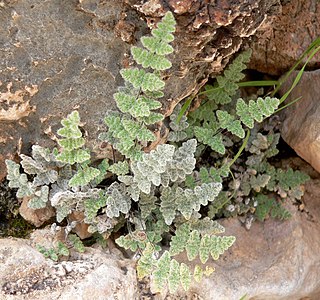
Cheilanthes, commonly known as lip ferns, is a genus of about 180 species of rock-dwelling ferns with a cosmopolitan distribution in warm, dry, rocky regions, often growing in small crevices high up on cliffs. Most are small, sturdy and evergreen. The leaves, often densely covered in trichomes, spring directly from the rootstocks. Many of them are desert ferns, curling up during dry times and reviving with the coming of moisture. At the ends of veins sporangia, or spore-bearing structures, are protected by leaf margins, which curl over them.

Pteridaceae is a family of ferns in the order Polypodiales, including some 1150 known species in ca 45 genera, divided over five subfamilies. The family includes four groups of genera that are sometimes recognized as separate families: the adiantoid, cheilanthoid, pteridoid, and hemionitidoid ferns. Relationships among these groups remain unclear, and although some recent genetic analyses of the Pteridales suggest that neither the family Pteridaceae nor the major groups within it are all monophyletic, as yet these analyses are insufficiently comprehensive and robust to provide good support for a revision of the order at the family level.
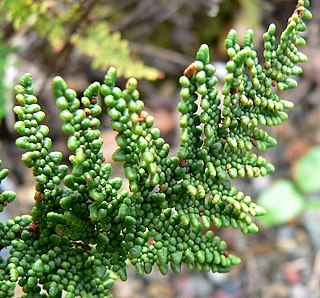
Myriopteris clevelandii, formerly known as Cheilanthes clevelandii, is a species of lip fern known by the common name Cleveland's lip fern.

Argyrochosma jonesii, known as Jones' false cloak fern, is a species of fern native to the southwestern United States and Sonora, Mexico. It grows on calcareous rocks, and has small, finely-divided leaves with a leathery texture and dark axes connecting the leaf segments. Unlike many members of Argyrochosma, it does not secrete white powder on the underside of its leaves. First described as a species in 1917, it was transferred to the new genus Argyrochosma in 1987, recognizing their distinctness from the "cloak ferns".

Astrolepis is a small genus of ferns in the family Pteridaceae. It was formed in 1992 from species previously placed in Cheilanthes and Notholaena. The name is derived from the Greek words ἄστρον, meaning "star," and λεπίς, meaning "scale," referring to the star-like scales on adaxial blade surfaces. Members of the genus are commonly known as star-scaled cloak ferns and are native to the Americas.
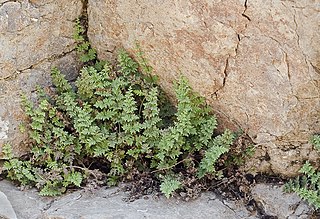
Myriopteris viscida, formerly known as Cheilanthes viscida, is a species of lip fern known by the common names viscid lip fern and viscid lace fern.

Calochlaena dubia, commonly known as soft bracken, false bracken, common ground fern or rainbow fern, is a small Australian fern in the treefern family Dicksoniaceae. It is very common within its range, and often seen growing under eucalyptus forest, often on the poorer quality soils. It is an easy plant to grow in the garden.
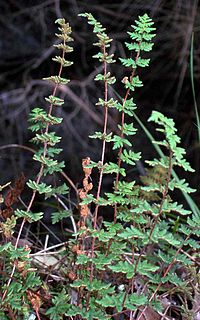
Cheilanthes sieberi is a small fern growing in many parts of Australia, New Zealand and nearby islands. Common names include poison rock fern and mulga fern.

Myriopteris tomentosa, formerly known as Cheilanthes tomentosa, is a perennial fern known as woolly lipfern. Woolly lipfern is native to the southern United States, from Pennsylvania to Arizona and Georgia, and Mexico.
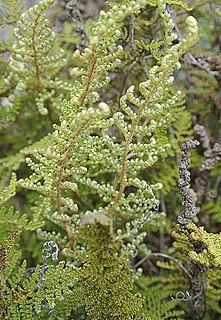
Myriopteris myriophylla, the Central American lace fern, is a species of lip fern. Despite its common name, this species is native as far south as Argentina. It is adapted to dry areas.
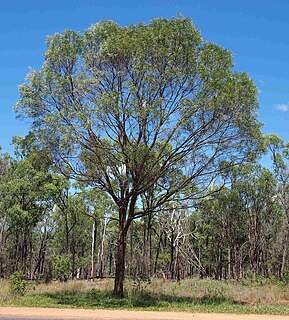
Acacia shirleyi, known colloquially as lancewood, is a species of Acacia native to Queensland and the Northern Territory in Australia. It grows as a tree to 15 metres (49 ft) high, with dark grey or black stringy bark and blue-grey foliage. The yellow flowers appear from March to July. It grows in dry scrub, open forest or mixed savannah woodland. Indigenous people used the wood as fuel and to make hunting spears. Cattle can eat the foliage as fodder.

The Cumberland Plain Woodland, or Western Sydney woodland, is a grassy woodland community found predominantly in Western Sydney, New South Wales, Australia, that comprises an open tree canopy, a groundcover with grasses and herbs, usually with layers of shrubs and/or small trees.

Argyrochosma dealbata, the powdery false cloak fern, is a small fern endemic to the central and southern United States. It grows on calcareous rocks, such as limestone. Its leaves are highly divided, with leaf segments joined by shiny, chestnut-brown axes, and their undersides are coated with white powder, giving the fern its name. First described as a species in 1814, it was transferred to the new genus Argyrochosma in 1987, recognizing their distinctness from the "cloak ferns".

Myriopteris aurea, the golden lip fern or Bonaire lip fern, is a moderately-sized fern native to the Americas, a member of the family Pteridaceae. Unlike many members of its genus, its leaf is only modestly dissected into lobed leaflets (pinnae), which are hairy both above and below. One of the cheilanthoid ferns, it was usually classified in the genera Cheilanthes as Cheilanthes bonariensis until 2013, when the genus Myriopteris was again recognized as separate from Cheilanthes. It typically grows on dry, rocky slopes, and ranges from Mexico, where it is extremely common and widespread, and the southwestern United States south and east through Central and South America as far as Chile and Argentina.

Argyrochosma fendleri, Fendler's false cloak fern, is a fern known from the western United States and northwestern Mexico. It grows in rocky habitats, and is distinguished from other members of the genus by its zig-zag leaf axes. Like many species in the genus, it bears white powder on the underside of its leaves. First described as a species in 1851, it was transferred to the new genus Argyrochosma in 1987, recognizing their distinctness from the "cloak ferns".

Argyrochosma microphylla, the small-leaf false cloak fern, is a species of fern native to New Mexico, Texas and northern Mexico. It grows on limestone rocks and cliffs, and has finely-divided leaves with small leaf segments, often folded in half when dry, which lack the white powder present on the leaf underside of many related species. First described as a species in 1869, it was transferred to the new genus Argyrochosma in 1987, recognizing their distinctness from the "cloak ferns".

Lastreopsis hispida, known as the bristly shield fern, is a common plant found in New Zealand. Less often seen in Australia, in cool rainforest areas with humus rich soils, or more rarely as an epiphyte on tree ferns or mossy logs. Listed as endangered in the state of New South Wales where it grows in a few remote sites in the Blue Mountains, such as at Mount Wilson. The specific epithet hispida is from Latin, meaning "bristly".
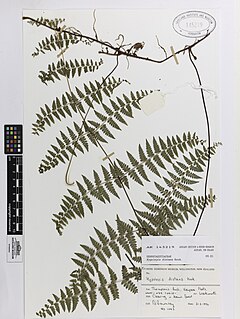
Hypolepis distans known as the scrambling ground fern is a small fern found in soils with a high humus layer, or swampy areas in New Zealand. Less often seen in Australia. Rarely recorded in north west Tasmania and King Island. There is one known population on the Australian mainland, at Macquarie Pass in New South Wales. An introduced population is at the remote Norfolk Island in the south Pacific Ocean. The scrambling ground fern features 20 to 40 pairs of primary pinnae, opposite or subopposite on the stem, at an angle of 90 degrees. The specific epithet distans is derived from Latin, meaning "widely spaced".

Myriopteris rawsonii, formerly known as Cheilanthes rawsonii, is a perennial fern native to Namaqualand.



















